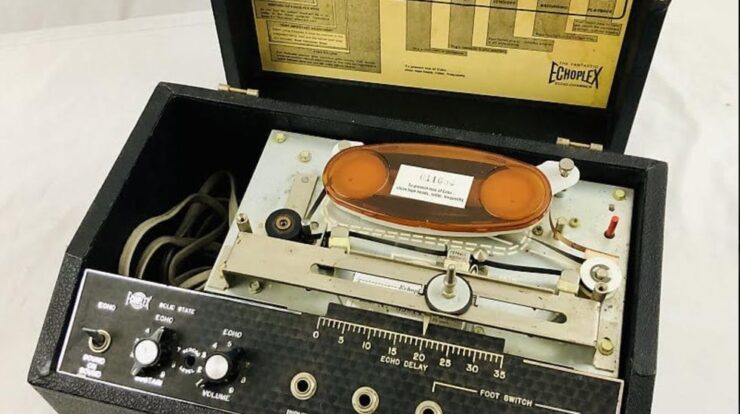
This post was originally published on this site

Feast your eyes on the missing link. I give you the coolest contraption to ever run between a guitar and an amplifier: the Maestro Echoplex.
The cool factor for this historic piece of gear is so off the chart that I’m always a bit shocked when players, young or old, are not familiar with this marvelous old-school tape-echo device. But no, I’m not writing this to copy and paste Wikipedia stats on this crown jewel of the guitar-pedal world. (However, if your inner nerdom is anything like mine, it’s worthy of a snoop. All of the Echoplexes from 1959 to the late ’70s sound amazing!) I’m writing to profess to all my fellow guitar gear freaks my undying love for something that was used on so many historical recordings that it’s mind-blowing. And while a big box with an analog tape loop might not be your idea of a great ride-along pal on tour, or even in the studio, truth is, there is nothing else exactly like an authentic Echoplex.
Do you remember the first time you heard that huge swelling repeat sound at the end of “Eruption” by Van Halen? Echoplex. How about the heaviness of Jimmy Page’s guitar on “Moby Dick” by Led Zeppelin? That’s a cranked Echoplex preamp, mis amigos!
The Echoplex design is pretty simple, which is one reason why it’s so iconic. It has actual tape that runs on the top of the unit, records your sound, then plays it back. Remember 8-track tape players? Yeah, kind of like that—except for the recording part. You just crank the slide in the middle—at least on the solid-state EP-3 model that I own—to make the delay effect go fast or slow. It’s not rocket science. But it does also work as a preamp and will enhance the tone of the guitar coming out of your amp like no other unit. Eric Johnson, for example, travels with one in a rack, sans tape, just so he can use the preamp for his classic tone. The Echoplex preamp basically boosts and compresses your signal, fattening it up and providing some EQ trickery that will have guitar players unfamiliar with the device’s charms scratching their heads.
The original Echoplexes come in four flavors: the EP-1, EP-2, EP-3, and EP-4. The EP-1 is the O.G.—the first tape delay ever, with a moving tape head that allows the delay time to be changed. It was made from ’59 to ’62, when the next generation of ’Plex, called the EP-2, not only gave the tape head more mobility but protected the tape itself in a cartridge. The solid-state version was the EP-3, which was used by Van Halen, Page, Tommy Bolin, and Brian May, among others. The EP-4 offered an output buffer to improve impedance-matching with other gear. Today, you can find early generation Echoplexes for anywhere from $1,400 to nearly $2,000, and the EP-3 and EP-4 are in the $600 to $1,500 range, depending on condition.
“I have all kinds of analog delay pedals but none of them compare to the Echoplex.”
There are related devices out there that some vintage-tone-inclined players, like Brian Setzer, prefer. The Roland Space Echo is one, and there’s the Binson Echorec. They’re easier for traveling because the Space Echo has a more efficient tape transport system and the Binson records on a drum rather than a length of tape. David Gilmour from Pink Floyd was a fan of the Echorec. But just remember, it is the original Echoplex sound those models were built to emulate. And both of those artists also used original Echoplex units on a few of their classic recordings.
Sure, you can buy some newfangled digital pedal that tries to recreate the Echoplex, but what fun is there in that? Where’s the potential for tape snarls or the manual cleaning required? After owning several EP-3 Echoplexes and using them in recording studios on countless tracks, touring all over the world with one in cars, vans, RVs, buses, and planes, I can tell you nothing replicates or enhances your tone like an EP-3. And if you do roll out with one, don’t forget Q-tips and a bottle of rubbing alcohol to clean the tape heads when they get dirty. If that doesn’t sound like a good time, then I guess you don’t wanna get the sound that fattened up the guitars in power trios like Joe Walsh’s James Gang or on Billy Gibbons’ first five ZZ Top albums.
I have all kinds of analog delay pedals but none of them compare to the Echoplex. Remember, a cool thing about owning vintage gear is not that it’s a piece of handcrafted history, but knowing that Leo Fender or Les Paul himself, or, in this case, Echoplex designer Mike Battle, is never making another one like the one that you own. Don’t get overwhelmed or anxious by projecting what could go wrong with it. Get excited about having a piece of gear that can make your guitar sound like almost every classic-rock, blues, and country record ever made.






